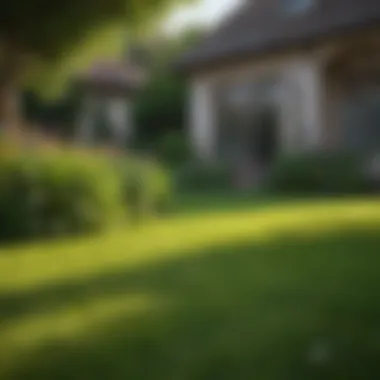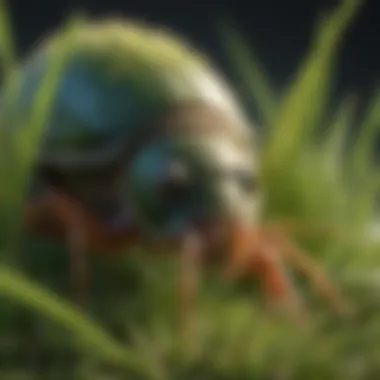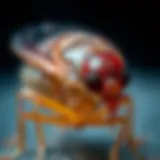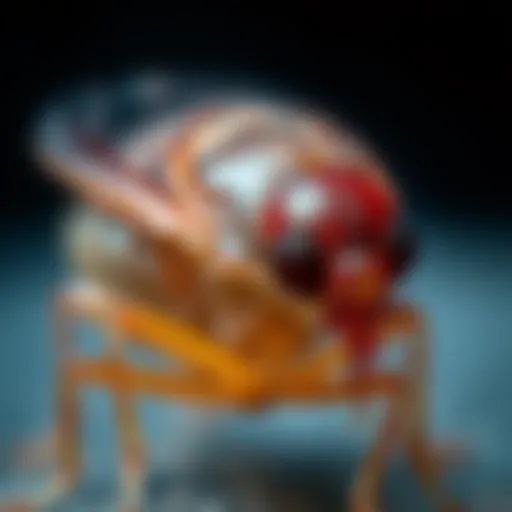Average Cost of Lawn Pest Control Explained


Intro
Pest Identification
Pest identification is crucial when addressing lawn issues. Recognizing the specific pests allows homeowners to choose the most effective treatment method.
Common Household Pests
Several types of pests frequently invade lawns. Some of the most common include:
- Grubs: These larvae feed on grassroots, damaging the lawn.
- Ticks: Known for being carriers of diseases, ticks can pose a health risk.
- Ants: While not always harmful, certain species can damage grass.
- Fleas: They can quickly infest the home from the yard.
Understanding which pest you are dealing with helps you to select a suitable pest control strategy.
Signs of Infestation
Detecting an infestation early can minimize damage and control costs. Look for the following signs:
- Browning patches: Indicate potential grub activity.
- Increased insect sightings: More bugs than usual may indicate a problem.
- Visible nests or mounds: Such as those created by ants or wasps.
By monitoring your lawn regularly, you can take action sooner, potentially reducing treatment costs.
Prevention Methods
Preventing pest issues is often more cost-effective than treating an existing problem. Several methods can help keep your lawn pest-free.
Environmental Modifications
Simple changes in the environment can deter pests effectively. Consider the following adjustments:
- Properly aerate the soil to promote healthy grass growth.
- Ensure adequate drainage to avoid standing water, which attracts pests.
- Maintain healthy grass height to discourage insect habitation.
Home Maintenance Tips
In addition to environmental changes, performing regular maintenance can also help:
- Regular mowing: Helps to keep grass healthy and less attractive to pests.
- Fertilizing as needed: Encourages strong roots, making the lawn more resilient.
- Removing debris: Clear away fallen leaves and debris where pests may hide.
These preventative measures can save you from costly pest treatments down the line.
DIY Pest Control Solutions
For those who prefer a hands-on approach, several DIY pest control solutions exist. These methods can help manage pests at a lower cost.
Natural Remedies
Utilizing natural ingredients offers an eco-friendly approach. Some options include:
- Diatomaceous earth: A safe powder that can kill soil-dwelling pests.
- Vinegar: Frequently used to deter ants and other insects.
- Garlic spray: Acts as a natural repellent for many pests.
DIY Traps and Barriers
Creating your own traps can be straightforward. You can make:
- Bottle traps: Suitable for capturing specific insects.
- Homemade barriers: Using household items to prevent pest entry.
By engaging in these DIY solutions, homeowners can reduce pest populations effectively.
Using a thoughtful combination of pest identification and prevention methods can significantly lower lawn pest control costs.


Understanding Lawn Pests
Lawn pests can be a significant issue for homeowners looking to maintain a healthy grassy area. Understanding the different types of lawn pests and their behaviors lays the groundwork for effective pest management. Their presence not only affects the aesthetics of your lawn but can also impact the overall health of the grass.
Recognizing specific pests is critical. Various pests like grubs and chinch bugs damage the roots and blades of the grass, leading to decline in health. Homeowners must know how to identify them and understand when action is needed. The benefits of understanding lawn pests include better preparedness and the possibility of a proactive approach to land care.
Additionally, considering the impact pests have on both appearance and lawn viability will encourage timely intervention. Without this understanding, you risk severe infestation, which can result in costly treatments and the need for lawn replacement.
Common Lawn Pests
Lawn pests come in various forms. Some of the most common include:
- Grubs: These are the larvae of beetles. They are often white and C-shaped. Grubs feed on the roots, causing significant damage.
- Chinch Bugs: Small, and black, they suck the sap from grass blades, leading to yellow patches.
- Fleas and Ticks: These pests can also infiltrate lawns, not just affecting grass but also posing risks to pets and humans.
- Aphids: Tiny and usually green, these can cluster on grass blades, sucking nutrients.
Understanding these pests assists homeowners in recognizing early signs of infestations, facilitating prompt measures for control.
Impact of Lawn Pests
The impact of lawn pests can be substantial. Pests such as grubs can lead to brown patches and dead areas on a lawn. Their feeding damages the grass roots, making recovery difficult without treatment. Chinch bugs, by drawing sap, can also create large discolored areas, which may lead homeowners to spend more on restoration.
"Timely intervention can save up to 50% of restoration costs by preventing severe damage caused by lawn pests."
In addition to aesthetic damage, these pests can affect playability for children and pets. Furthermore, some pests spread diseases that can harm not only the grass but also adjacent plants. A thorough understanding of how these pests impact lawns can lead to informed decisions and methods to protect the investment made in landscaping.
Factors Affecting Cost
Understanding the factors that affect the cost of lawn pest control is critical for homeowners. This knowledge allows for better budget planning and informed decisions on pest management strategies. The costs may appear straightforward at first but vary significantly depending on several key elements.
These factors include the type of pest, the extent of infestation, the treatment method chosen, the frequency of application, and geographical location. Each of these aspects plays a role in determining the overall financial commitment required to maintain a healthy, pest-free lawn.
By examining these factors in detail, readers can glean valuable insights that could lead to more economical choices and effective pest control practices.
Type of Pest
The type of pest present in a lawn is one of the most significant factors affecting cost. Different pests require different treatments. For instance, grubs often necessitate a specific type of pesticide that targets their lifecycle. Conversely, dealing with aphids may require a completely different solution.
Certain pests are harder to manage and may need multiple applications to eradicate. Common pests influencing costs include:
- Grubs: Often require targeted chemical treatments.
- Chinch Bugs: Need specific insecticides that may be more expensive.
- Fleas and Ticks: Treatment tends to involve a variety of steps and products.
Ignoring the pest type can lead to ineffective treatments and increased expenses over time.
Extent of Infestation
The infestation level of pests can drastically affect pest control costs. A minor infestation might be manageable with fewer treatments and lower-cost solutions, while a severe infestation can escalate costs significantly due to required multiple treatments and potential lawn restoration.
For example, a lawn suffering from a significant chinch bug infestation may need intensive treatment, in addition to soil replacement or reseeding after the treatment has been applied. Homeowners should assess the situation early and consider preventive measures to keep costs down.
Treatment Method
The chosen treatment method also impacts the overall expenses. Various methods include chemical pesticides, organic options, and integrated pest management strategies. Chemical solutions tend to provide quicker results but may impose higher costs due to their formulation and application process.
In contrast, organic treatments usually cost less, but they may require more time to see effectiveness. A decision on treatment should include both the financial aspect and health considerations for the environment.
Frequency of Treatment
Frequency is another crucial element in determining costs. Some pests may require one-time treatments, while others can necessitate regular applications to maintain control. Regular treatment programs, particularly on a monthly basis, can lead to higher overall costs, but they often result in healthier lawns in the long term.
Homeowners should weigh the cost of frequent treatments versus the potential damage unchecked pests can cause to their lawns. The trade-off between time, money, and lawn health is essential for effective financial management.
Geographical Location


Lastly, geographical location has a noticeable impact on costs. Rates for pest control services can vary widely from one region to another. Urban areas, for instance, might see higher prices due to increased demand and operational costs. Different regions also have varying pest challenges due to climate, local flora, and fauna.
Being aware of these differences can help homeowners choose the most cost-effective pest control solutions, tailored to their specific locale.
Average Cost Range
Understanding the average cost range for lawn pest control is essential for homeowners. This knowledge helps in planning a budget for pest management. Additionally, multiple factors influence these costs, making it necessary to assess them beforehand. Homeowners want effective solutions, but they also seek value for money. Knowing the price range allows them to compare service providers and make informed decisions about their lawn care.
General Pricing Overview
The pricing for lawn pest control often varies significantly. Generally, it can range from $100 to $400 depending on certain conditions. Several parameters come into play. These include the type of pest, the extent of infestation, and the chosen treatment method. For instance, minor infestations may require less expenditure. Conversely, severe infestations will incur higher costs due to the extensive treatments needed.
It is important to note that initial treatments are usually pricier. This is because they may involve comprehensive assessments and multiple applications. Ongoing treatments typically cost less since they may only entail maintenance applications.
Cost for Different Pests
Grubs
Grubs are a prevalent lawn pest, known for their destructive feeding habits. They cause significant damage to roots of grass, leading to dead patches. The cost to treat grubs can range from $150 to $300, depending on the severity of the infestation. The primary characteristic of grubs is their lifecycle. They are typically most problematic in late summer and early fall.
Treating grubs usually involves insecticides or biological controls. A common treatment method is applying nematodes. They are beneficial because they target grubs specifically without harming other garden insects. However, the use of chemical treatments can be a concern for some homeowners.
Chinch Bugs
Chinch bugs are another significant lawn pest. They thrive in hot weather and suck the sap from grass. Their presence is often indicated by yellowing patches on the lawn. The costs to control chinch bugs can vary from $100 to $250, depending on the required methods. A key characteristic of chinch bugs is their rapid reproduction. This can lead to a swift infestation, making early detection crucial.
Treatments often include insecticides that target adult chinch bugs. Some products may be eco-friendly, appealing to environmentally-conscious homeowners. However, proper application is necessary since incorrect treatment can lead to poor results.
Fleas and Ticks
Fleas and ticks, while often associated with pets, can also affect lawns. These pests can carry diseases, raising concerns for homeowners. The average treatment cost for fleas and ticks ranges from $150 to $300. Their key characteristic is their survival on host animals. This often leads to their spread throughout the yard.
To manage fleas and ticks, homeowners can use both chemical and non-chemical methods. Treatments can include sprays or granules designed for outdoor use. These methods can be effective but may need repeat applications to ensure eradication. Some homeowners prefer using integrated pest management to reduce reliance on chemicals.
Understanding the cost implications of various pests allows homeowners to budget accordingly. Being aware of the pests common in one’s locality aids in effective lawn care planning.
DIY Pest Control Solutions
Engaging in DIY pest control solutions can be a viable option for homeowners looking to manage lawn pests efficiently and affordably. This approach not only empowers individuals to take charge of their lawn health but also offers various benefits that align with budget-conscious strategies. With effective methods readily available, homeowners can minimize the costs associated with professional pest control services. Understanding DIY pest control is essential for those aiming to keep their lawns in optimal condition without excessive expenditure.
Cost-Effective Methods
One of the primary advantages of DIY pest control is the potential for significant cost savings. Many methods can be employed that utilize natural or easily accessible ingredients. Here are some cost-effective methods to consider:
- Natural repellents: Ingredients like vinegar, dish soap, and essential oils can deter pests without harming the environment.
- Homemade traps: Utilizing simple materials, such as soapy water for insects or beer to lure slugs, can be effective.
- Manual removal: For small infestations, physically removing pests can provide immediate relief without the cost of chemical treatments.
- Beneficial insects: Introducing ladybugs or lacewings can help control pest populations, adding a natural layer of pest management.
These methods tend to cost significantly less than professional treatments, often requiring only basic household supplies or minimal investment. However, it is crucial to identify the specific pests affecting your lawn to choose the most effective strategy.
Advantages and Disadvantages
Despite the apparent benefits, DIY pest control does come with its own set of advantages and disadvantages. Understanding both is vital for proper decision-making.
Advantages:
- Customization: Homeowners can tailor their approaches based on specific pest issues and environmental conditions.
- Accessibility: Many DIY methods utilize common household products, making them easy to acquire and implement.
- Cost Savings: Avoiding professional fees can lead to substantial financial savings in managing lawn health.
Disadvantages:
- Effectiveness: Some DIY solutions may not be as strong or effective as commercial products, potentially leading to prolonged infestations.
- Time-Consuming: Implementing and monitoring DIY strategies can require more time compared to hiring professionals.
- Lack of Expertise: Homeowners may lack the knowledge of pest behaviors and treatments, which can lead to ineffective solutions.


Ultimately, success in lawn pest control through DIY methods relies on research and understanding of both pests and potential solutions. It is important to evaluate the effectiveness of these methods and determine if they adequately address the issue at hand.
Many homeowners find that a combination of DIY methods and professional services offers the best approach to managing lawn pests effectively, allowing for both cost savings and expert intervention when needed.
Professional Pest Control Services
One of the primary benefits of hiring a professional is expertise. Pest control specialists possess extensive knowledge about various pests, their life cycles, and the most effective methods of eradication. They can identify specific infestations more accurately than an untrained eye, ensuring that the treatment applied is appropriate. Furthermore, professionals have access to advanced treatments and products that might not be available in retail outlets. These solutions are often more potent and specialized to deal with specific types of pests, ultimately improving effectiveness.
Cost-wise, opting for a professional service does present upfront expenses. However, the potential for long-term savings should be a critical consideration. Professionals not only treat existing pest problems but also implement preventative measures that can reduce future infestations. Long-term treatment contracts might also offer better value for money. This can be beneficial in managing the recurring costs associated with maintaining a pest-free lawn.
Another aspect to consider is the liability and safety involved in using pest control products. Professionals are trained to handle and apply pesticides safely, reducing the chances of accidents or incorrect application. This is particularly important for households with pets and children, where even minor exposure to harmful chemicals can pose significant risks. By opting for certified pest control, homeowners can ensure a safer environment while effectively managing pests.
Choosing a Provider
Selecting a pest control provider is a significant decision. It involves assessing several factors to ensure that the chosen service will meet specific needs. One of the first steps is to evaluate qualifications and experience. Providers should possess licenses and certifications that are relevant to their state's regulations. This indicates that they have received proper training and adhere to safe pest control practices.
Beyond credentials, researching customer reviews can provide insight into the reliability and quality of services. Homeowners should seek out providers with positive feedback regarding their treatment effectiveness and customer service. Obtaining quotes from multiple companies may help in comparing prices and service offerings, ensuring that the chosen provider fits within budget without compromising on the quality of care.
Lastly, consider a provider’s approach to pest control. Integrated pest management (IPM) methods focus on environmentally sensitive treatments. This ensures that the pest control measures are not only effective but also sustainable.
Typical Service Packages
Most professional pest control companies offer various service packages tailored to different pest issues and homeowner needs. The first type often includes a thorough inspection of the property, which comes with an initial consultation fee. During this inspection, the technician assesses the lawn for signs of infestation and the type of pests present.
Based on the findings, the service provider may suggest a treatment plan that can include several visits over a specified timeframe. Typical packages can vary in scope:
- Basic Treatment Package: This usually covers one-time treatments for identified pests. It can be suitable for homeowners facing a minor infestation.
- Standard Maintenance Package: This involves scheduled maintenance visits, typically quarterly or semi-annually. It is designed for ongoing pest management and includes check-ups and treatments as necessary.
- Comprehensive Package: A more extensive option, this may cover a wider variety of pests across multiple treatments, with customized plans based on signage and seasonal pest activity.
When considering which package to choose, it is beneficial to weigh the cost against the anticipated efficacy. Understanding the offered services provides clarity on the expected outcomes, leading to a decision that delivers value and peace of mind in pest management.
Long-Term Cost Considerations
Long-term cost considerations are essential when it comes to managing lawn pest control. This section delves into how upfront investments can translate into savings and overall lawn health over time. By focusing on preventative measures, homeowners can minimize potential infestations and the financial strain that often accompanies them. Not only does this approach balance immediate costs with future savings, but it also contributes to a healthier environment for both the lawn and the community.
Preventative Measures
Preventative measures can significantly reduce the overall costs of pest control. Implementing strategies early can prevent worse damage down the line. Regular maintenance practices can include:
- Regular Mowing: Keeping grass at an appropriate height helps discourage certain pests from settling.
- Soil Testing: By sampling and assessing soil quality, you can effectively identify nutrient deficiencies that might attract pests.
- Proper Watering: Over-watering can lead to conditions favorable for pests, while too little water can stress plants and make them more susceptible to infestation.
- Planting Pest-Resistant Varieties: Choosing grass and plants that naturally deter pests can be a long-term cost-saving strategy.
- Natural Barriers: Introducing beneficial insects, such as ladybugs, can help control pest populations biologically.
Overall, adopting preventative measures not only protects against pest outbreaks but also requires a lower financial investment compared to reactive treatments, making it a smart choice for homeowners.
Cost-Benefit Analysis
Conducting a cost-benefit analysis of lawn pest control can guide homeowners to make informed decisions. This analysis compares the costs of preventative measures and treatments against the potential expenses of pest damage, including loss of turf quality, additional treatment applications, and restoration costs. Factors to consider include:
- Initial Investment in Preventatives: The cost of adopting practices or products that prevent pests often pays off in fewer treatments needed later.
- Cost of Treatment for Infestations: The financial burden of eradicating an established pest population can be substantial, often necessitating several treatment sessions.
- Long-term Lawn Health: A well-maintained lawn not only looks better but can increase property value. Healthier grass is less likely to suffer from pest infestations.
A comprehensive analysis highlights that spending on preventive measures often represents a fraction of what reactive treatment would cost over time.
Culmination
The conclusion serves a pivotal role in this article on lawn pest control costs. It synthesizes essential elements discussed previously, providing a clear picture of the financial implications associated with maintaining a pest-free lawn. This final section not only revisits the key findings but also offers practical insights that can guide householders and property owners in their pest management decisions.
Summary of Findings
The analysis outlined throughout the article emphasizes several significant points. Firstly, the average costs vary substantially based on the type of pests, the extent of the infestation, and the treatment methods employed. It became evident that regions also influence pricing, often due to local labor costs and pest susceptibility. For instance, professional services may range widely from one area to another, necessitating careful research and comparisons to make informed choices.
Additionally, the long-term costs and benefits of both DIY solutions and professional services highlight the importance of preventive measures. Engaging in regular maintenance can reduce overall expenses by addressing smaller issues before they become significant problems. By taking proactive steps, homeowners can manage their budgets effectively while ensuring the health of their lawns.
Final Recommendations
As the findings suggest, homeowners should adopt a multifaceted approach to lawn pest control. Begin by thoroughly assessing the lawn for signs of pests, which can make subsequent treatments more targeted and effective. From there, consider the following recommendations:
- Consult Multiple Providers: Always obtain estimates from various pest control services to compare prices and treatment options. This can help find a service that fits the budget.
- Explore DIY Treatments: Some minor infestations can be managed with do-it-yourself approaches. Research safe and effective home remedies that can minimize costs while still providing results.
- Prioritize Preventative Measures: Invest time and resources into preventative care such as regular lawn maintenance, proper watering, and fertilization. This practice can save money in the long run by preventing larger infestations.
- Stay Informed on Local Pest Trends: Understanding which pests are prevalent in your region can help you prepare in advance. Awareness leads to timely interventions before infestations grow out of control.
By following these guidelines, homeowners can navigate the complex landscape of lawn pest control costs with confidence, ensuring they are making informed and economically sound decisions.















